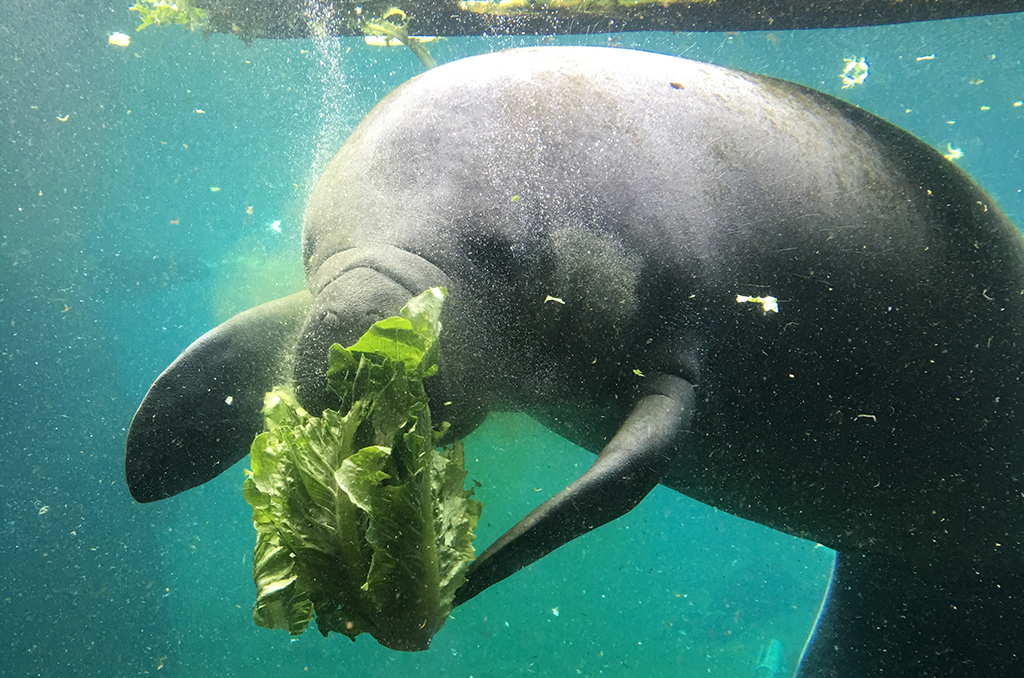Manatee Eating Lettuce — Courtesy: Shutterstock — Mary-Kaitlyn Arnette
Researchers have discovered that manatees, who have long been regarded as some of Florida’s most adored and captivating residents, are not native to the Sunshine State and arrived just like any other visitor in quest of the warm temperatures and crystal-clear seas.
Scientists from George Washington University (GWU) and the University of South Florida (USF) made a shocking discovery that challenges decades of assumptions about the origins of the endangered species, which was formerly common in the Caribbean, the Gulf of Mexico, and the Florida peninsula.
Less than 9,000 sea cows are thought to live in Florida’s waterways, and the discovery may also provide a means of survival for these animals.
USF anthropology professor Thomas Pluckhahn said that bowhead whale populations had recovered dramatically, with conservation efforts fueled in part by a greater understanding of the species’ location and history.
“Biologists frequently attempt to establish management goals based on historical baselines, but frequently those are merely hypothesized rather than proven. “They frequently give native species a lot of priority,” he said.
The management of manatees may benefit from historical records, perhaps attempting to adopt a more detailed approach to population histories and using them to establish goals. Research on other species, such as bowhead whales, has shown that their populations are distinct and that their histories of whaling and exploitation have had varying effects on them.
In an attempt to save Florida manatees, conservationists plant sea grasses. On October 5, 2021, in Homosassa, Florida, a manatee swims in the Homosassa River amidst seagrass. After a record year of manatee deaths in Florida, conservationists, including those from the Homosassa River Restoration Project, plant seagrass in the area to help restore the natural habitat for manatees and offer a feeding ground for the mammals. The loss of seagrass beds caused hunger, which was the main cause of the deaths. (Getty Images/Joe Raedle photo)
A glimmer of hope for Florida’s hard-hit manatees is the recovery of seagrass.
Pluckhahn, who co-authored the study with David Thulman, a professor of archaeology at GWU, compared manatees to what locals refer to as “snowbirds,” who are seasonal visitors from colder climates to Florida.
He said that during the small ice age, which lasted from about 1300 to the middle of the 1800s, Florida’s waters were too cold for manatees. The scientists contend that manatees did not start migrating north in greater numbers during Florida’s colonial era, which lasted from the 16th to the 19th century, when it was thought that Spanish and British residents might have hunted them.
“Archaeological and archival records before the late 1700s show very little evidence of manatees, and the most likely explanation is that they were present only occasionally,” Pluckhahn stated.
The fact that most manatee bones are made into tools or decorations and that there are a few known examples in Florida’s archeological records raises the possibility that they were traded from the Caribbean.
It’s also possible that they existed but were not hunted, but I don’t think that kind of taboo would have persisted for 10,000 years or more, and it doesn’t explain why they wouldn’t appear in Spanish records or on Spanish sites.
Additionally, we don’t see any artwork. We may anticipate that Native Americans would be represented if manatees were significant to them. Native American art in Florida also depicts other animals, such as dolphins, panthers, and so on. But manatees are not visible to us.
Puckhahn and Thulman were inspired to work together on their study because of the anecdotal underrepresentation of a species that is purportedly so embedded in Florida’s historic culture. After looking through dozens of pre-colonial archeological documents and the archives of explorers and settlers who arrived in Florida starting in the middle of the 1500s, they discovered that there were not many mentions of manatees.
They said that media reports of manatees being often seen along Florida’s east coast, from Miami to St. Augustine, started to increase in the 1920s and that by the 1950s, they were “becoming more plentiful” in Tampa Bay and along the Gulf of Mexico coast.
“Manatees are limited by the occurrence of cold spells,” Pluckhahn stated. However, the environment changed as a result of climatic change, creating warm-water refuges such canals and yacht basins, which is where manatees were most frequently seen in the late 1800s and early 1900s.
“After that, power plants took over as the main source of warm water refuge outside of natural springs as power production increased, starting in the 1920s.”
While acknowledging that neither he nor Thulman are biologists, Pluckhahn thinks that their research will aid in decision-making as the restoration of the endangered species moves forward.
“We don’t know if it’s possible to create more manatee refuges or to make existing ones more manatee friendly, but we’re going to need more warm-water refuges for manatees as the fossil fuel plants close,” he said. “As we’ve highlighted, some of the earlier manatee refuges were kind of passive, solar, shallow-water features,” he said.
The US Fish and Wildlife Service (FWS) has been considering restoring manatees to the “endangered” classification that was taken away from them in 2017 under Donald Trump’s first administration. A public comment period regarding updated or new critical habitat designations for two subspecies, the Florida manatee and the Antillean manatee in Puerto Rico, will be extended until late January, the service announced last month due to hurricanes Helene and Milton this year.
A coalition of advocacy organizations, including Defenders of Wildlife, the Save the Manatee club, and the Center for Biological Diversity, told FWS in a statement that the Florida manatee’s future is uncertain and that the ongoing loss of vital warm water and foraging habitat poses a serious threat to its long-term survival.
They claimed that rather than addressing the service’s long-term plans to guarantee the survival and recovery of the species, conservation efforts “have been largely focused on the immediate need to rescue stranded manatees.”
Stories that matter are our priority. At Florida Insider, we make sure that the information we provide our readers is accurate, easy-to-read, and informative. Whether you are interested in business, education, government, history, sports, real estate, nature or travel: we have something for everyone. Follow along for the best stories in the Sunshine State.

Born and raised in South Florida, Krystal is a recent graduate from the University of Miami with professional writing experience at the collegiate and national news outlet levels. She’s a foodie who loves all things travel, the beach, & visiting new places throughout Florida.

